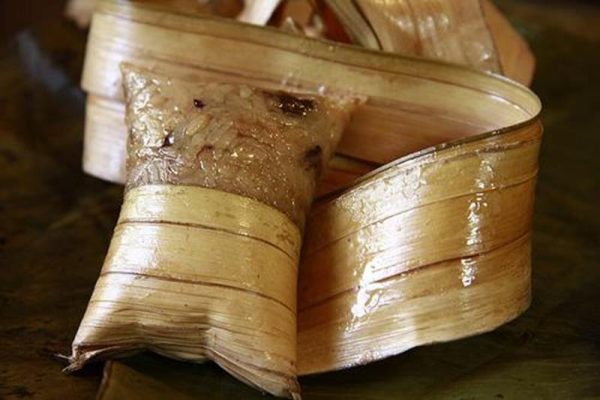The Coconut Cake of Giong Luong

Giong Luong formerly was the place name of a stretch of elevated land along the bank of Ham Luong River, Ben Tre Province. It had gone into the far back past for a long time, and now just exists in the memories of the people who have been living here for generations. Now it is called Dai Dien Commune, and life is just as miserable and hard as in the old time. However, Giong Luong is not only a land of misery and hardship, it also has the long-favoured kind of cake called banh dua (coconut cake), locally made from boiled sticky rice mixed with black bean or adsuki and rolled in strips of nipa tender leaf. The real cake tastes wonderfully and has gone into locals’ memory for as long as half a century. It is also a means of livelihood for poor villagers who do not have any rice paddies and have no jobs to do. It has now been considered a traditional foodstuff that needs to retain. And, along with the twists and turns of the cake are lots of ups and downs in the life of the cake makers. “SECRETS” OF THE CAKE One of the most important secrets of banh dua is the choice of sticky rice as its main ingredient. Whether the material is properly chosen or not decides the quality of the cake. It is a belief among cake makers in Giong Luong that the sticky rice must be the species grown in Vinh Long rice paddies for it is truly sticky and fragrant. Formerly, the sticky rice from Tra Vinh rice paddies was the best choice, but this now has been degenerating coupled with the environmental impacts of the abuse of chemical fertilizers in farming practices. For the cake to come into form, the cake makers have to go through painstaking jobs. First, they have to prepare the sticky rice by soaking it in cold water for several hours from midnight. Then they have to get up at around 4 o’clock in the morning to wash the rice carefully for several times (usually 6 or 7 times). This step is very important because if not done well or correctly, there may be The next step is to prepare coconut extracted milk. Too ripe (dry) coconut is not preferred for they may cause unwanted oily smell in the cake. Niether is the unduly ripe coconut for it may have insufficient fatness. The best choice is the thick-mealed and golden-skinned coconut, that is the moderately ripe one. The art of making the nipa wrappings is also very hard and not everybody can do it. It requires true dexterity of the maker. That is why coconut cake making is the secret under control by a small number of people, and is passed from generation to generation. The wrappings must be put in shadowy place because the nipa tender leaf may decolor and contract under effect of sunlight. The cake being crammed to full will be fastened by strings also taken from the nipas. The fastening also requires very strict techniques. It is a failure to fasten the cake either too tight or too loose. All the job of putting the rice into nipa wrappings must be finished by 7 o’clock in the morning before the cake being boiled in 5 more hours. Cake boiling is a very hard job, and if not done correctly and carefully, it may erase all the cake maker’s efforts. So when boiling, the cakes are fastened in clusters of 12 pieces each. Then clusters of cakes must be put in one after the other and only when the water is boiling up. The water in which to boil cakes also must be very clean and clear. Some alum is required in order to keep the cakes in good color, and the amount of alum may be decisive on the taste and the color of the cake, too Photo: http://coconutvietnam.com.vn
|





